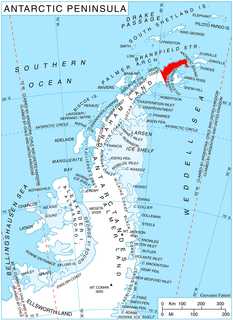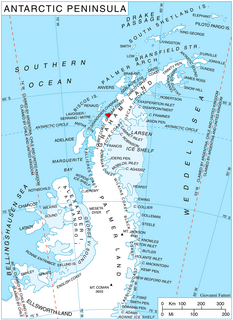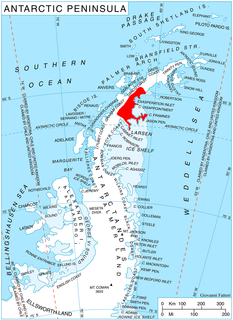
Aitkenhead Glacier is a 10-mile (16 km) long glacier flowing east-southeast from the Detroit Plateau, Graham Land, into Prince Gustav Channel. It was mapped from surveys by the Falkland Islands Dependencies Survey (FIDS) (1960–61), and named by the United Kingdom Antarctic Place-Names Committee for Neil Aitkenhead, a FIDS geologist at Hope Bay (1959–60).

Prospect Point is a headland at the west extremity of Velingrad Peninsula on Graham Coast in Graham Land, nearly 2 nautical miles (3.7 km) south of Ferin Head and immediately east of the Fish Islands. Roughly charted by the British Graham Land Expedition (BGLE) under Rymill, 1934-37. Photographed by Hunting Aerosurveys Ltd. in 1956-57. The name was suggested in 1957 by E. P. Arrowsmith, Governor of the Falkland Islands.
Ashton Glacier is a glacier 9 nautical miles (17 km) long, which flows east-southeast from Mount Thompson to the northwest side of Lehrke Inlet, on the east coast of Palmer Land. The glacier was photographed from the air in December 1940 by the United States Antarctic Service (USAS), and was probably seen by the USAS ground survey party which explored this coast. A joint party consisting of members of the Ronne Antarctic Research Expedition and the Falkland Islands Dependencies Survey (FIDS) charted the glacier in 1947. It was named by the FIDS for L. Ashton, a carpenter with the FIDS at the Port Lockroy and Hope Bay bases in 1944–45 and 1945–46, respectively.

Bolton Glacier is a glacier flowing into the head of Briand Fjord, Flandres Bay, on the west coast of Graham Land. It was mapped in 1959 by the Falkland Islands Dependencies Survey from photos taken by Hunting Aerosurveys Ltd in 1956–57, and named by the UK Antarctic Place-Names Committee for William B. Bolton (1848–89), English photographer who, with B.J. Sayce, invented the collodion emulsion process of dry-plate photography in 1864.

Bottrill Head is a rugged headland on the east side of Bourgeois Fjord which forms the southwest extremity of German Peninsula and the north side of the entrance to Dogs Leg Fjord in Fallières Coast, on the west side of Graham Land, Antarctica. It was first surveyed in 1936 by the British Graham Land Expedition (BGLE) under John Rymill. The headland was resurveyed in 1948 by the Falkland Islands Dependencies Survey (FIDS) who named it for Harold Bottrill, Chairman of the Board of Directors, later General Manager, of Maclean and Stapledon S.A., shipping agents at Montevideo, who gave great assistance to the BGLE, 1934–37, and to FIDS, 1943–48.
Jupiter Glacier is a glacier on the east coast of Alexander Island, Antarctica, 10 nautical miles (19 km) long and 5 nautical miles (9 km) wide at its mouth, which flows east into George VI Sound to the south of Ablation Valley. It was first photographed from the air on November 23, 1935, by Lincoln Ellsworth and mapped from these photos by W.L.G. Joerg. It was roughly surveyed in 1936 by the British Graham Land Expedition, and was named for the planet Jupiter by the Falkland Islands Dependencies Survey following their surveys in 1948 and 1949.

Mount Deeley is a mountain 2,150 metres (7,050 ft) high, on Pernik Peninsula, Loubet Coast in Graham Land, standing 6 nautical miles (11 km) northeast of Salmon Cove. It was mapped from air photos taken by the Falkland Islands and Dependencies Aerial Survey Expedition of 1956–57, and it was named by the UK Antarctic Place-Names Committee for Richard M. Deeley, a British geologist who made important investigations of the structure and flow of glaciers.
Tumble Glacier is a glacier extending along the east side of Alexander Island, Antarctica, 7 nautical miles (13 km) long and 3 nautical miles (6 km) wide, which flows east from the cliffs of Mount Egbert, Mount Ethelwulf and Mount Ethelred of the Douglas Range into the west side of the George VI Ice Shelf that occupies George VI Sound immediately south of Mount King. The glacier was first roughly surveyed in 1936 by the British Graham Land Expedition under Rymill. Resurveyed in 1948 by the Falkland Islands Dependencies Survey, and so named by them because of the extremely broken condition of the lower reaches of the glacier.

Punchbowl Glacier is a glacier that flows southwards between Poibrene Heights and Metlichina Ridge, and enters the north end of Exasperation Inlet, north of Jorum Glacier, on the east side of Graham Land, Antarctica. Surveyed by Falkland Islands Dependencies Survey (FIDS) in 1947 and 1955. The name applied by United Kingdom Antarctic Place-Names Committee (UK-APC) is descriptive of shape as the glacier is hemmed in by mountains.

Mount Egbert is a mainly ice-covered mountain, 2,895 metres (9,500 ft) high, 8 nautical miles (15 km) south-southeast of Mount Stephenson in the Douglas Range of Alexander Island, Antarctica. It was possibly first seen in 1909 by the French Antarctic Expedition under Jean-Baptiste Charcot, but was not recognized as a part of Alexander Island. It was surveyed in 1936 by the British Graham Land Expedition under John Rymill, then resurveyed in 1948 by the Falkland Islands Dependencies Survey, who named the mountain for Egbert, a ninth-century Saxon king of England. Mount Egbert is the second highest peak of Alexander Island, while Mount Stephenson remains the highest point.
Friederichsen Glacier is a glacier 7 nautical miles (13 km) long, which flows in an easterly direction into Cabinet Inlet, close north of Mount Hulth, on the east coast of Graham Land, Antarctica. It was charted by the Falkland Islands Dependencies Survey (FIDS) and photographed from the air by the Ronne Antarctic Research Expedition in 1947. It was named by the FIDS for Ludwig Friederichsen, a German cartographer who in 1895 published a chart based upon all existing explorations of the Antarctic Peninsula and the South Shetland Islands.
Mount Morton is a mountain standing between Blériot Glacier and Cayley Glacier on the west coast of Graham Land, Antarctica. It was photographed by the Falkland Islands and Dependencies Aerial Survey Expedition in 1956–57, and mapped from these photos by the Falkland Islands Dependencies Survey. The mountain was named by the UK Antarctic Place-Names Committee in 1960 for Grant Morton, an American aviator who made the first parachute descent from an airplane using a parachute carried loosely.
Lizard Hill is a narrow, curving rock ridge, 355 metres (1,165 ft) high, standing 2 nautical miles (4 km) southwest of Trepassey Bay and 0.5 nautical miles (1 km) east of Ridge Peak, on Tabarin Peninsula, Antarctica. The hill was probably first seen by the Swedish Antarctic Expedition, 1901–04, under Otto Nordenskjöld, and was first charted in 1946 by the Falkland Islands Dependencies Survey, who applied the descriptive name.

The Miller Heights are a series of elevations extending eastward from Sharp Peak on Velingrad Peninsula, Graham Coast on the west side of Graham Land, Antarctica. The feature was roughly charted by the British Graham Land Expedition under John Rymill, 1934–37, and was named by the UK Antarctic Place-Names Committee for Ronald Miller, a Falkland Islands Dependencies Survey general assistant at Detaille Island in 1956 and leader at Prospect Point in 1957.
Huns Nunatak is a nunatak rising to about 950 metres (3,120 ft) in the center of the Milky Way, a mountain pass between the LeMay Range and the Planet Heights, in the central portion of Alexander Island, Antarctica. The name originates from dog teams named "The Huns" that served at various British stations in Antarctica, 1961–74, and honors the loyal service of all Falkland Islands Dependencies Survey/British Antarctic Survey sled dogs. Huns Nunatak seems to bear some relation to Admirals Nunatak, which lies about 6 kilometres (3.7 mi) to the southwest, considering they are both named after a team of sled dogs.

Tammann Peaks are peaks on Pernik Peninsula, Loubet Coast in Graham Land, standing 4 nautical miles (7 km) southeast of Orford Cliff and a like distance east of Lallemand Fjord. Mapped from air photos taken by Falkland Islands and Dependencies Aerial Survey Expedition (FIDASE) (1956–57). Named by United Kingdom Antarctic Place-Names Committee (UK-APC) for Gustav H.J.A. Tammann, German physical chemist who (1900–1935) made important studies of the physical properties of ice.
Temple Glacier is a glacier flowing into the south side of Lanchester Bay on the west coast of Graham Land. Photographed by Hunting Aerosurveys Ltd. in 1955-57 and mapped from these photos by the Falkland Islands Dependencies Survey (FIDS). Named by the United Kingdom Antarctic Place-Names Committee (UK-APC) in 1960 for Felix Du Temple (1823–1890), French naval officer who in 1857 designed the first powered model airplane to rise unaided, fly freely and land safely.
Target Hill is a prominent hill which rises 1,010 m above the level of Larsen Ice Shelf. It stands 6 nautical miles (11 km) west of Mount Fritsche on the south flank of Leppard Glacier in eastern Graham Land. The hill was the most westerly point reached by the Falkland Islands Dependencies Survey (FIDS) survey party in 1955; it was visible to the party as a target upon which to steer from the summit of Richthofen Pass.
Lampitt Nunatak is a nunatak near the head of Murphy Glacier, in Graham Land, Antarctica. It was photographed by Hunting Aerosurveys Ltd in 1955–57, and mapped from these photos by the Falkland Islands Dependencies Survey. It was named by the UK Antarctic Place-Names Committee in 1958 for Leslie H. Lampitt (1887–1957), a chemist who contributed many ideas for concentrated rations used by British polar expeditions during the period 1937–57.
Les Dents is a conspicuous landmark consisting of four toothlike peaks, uniform in height and rising to about 1,500 metres (5,000 ft) between Mount Bayonne and Mount Paris, situated within the Rouen Mountains in the northern part of Alexander Island, Antarctica. The feature was first roughly mapped and named "Les Dents" by the French Antarctic Expedition, 1908–10, under Jean-Baptiste Charcot. It was further mapped, from air photos taken by the Ronne Antarctic Research Expedition, 1947–48, by D. Searle of the Falkland Islands Dependencies Survey in 1960.










